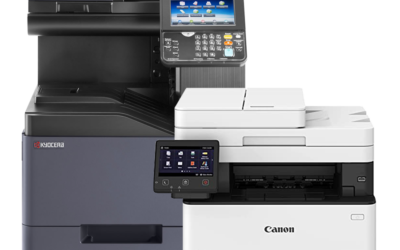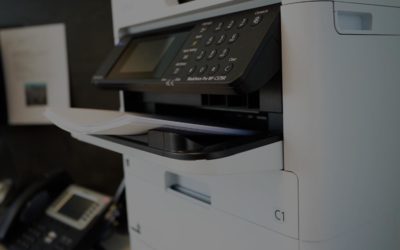A Case of Blurry Faxes
Mark sighs. One hand tugs on his thick black beard while the other holds a faxed purchase order from his biggest customer. He glares at the squiggly, black lines blurring the center of the page. “Why does my fax machine keep doing this?” He plops down with disgust, picks up his desk phone, and punches in (330) 674-2251.
“Thanks for calling Think Ink. This is Dave. What can I do for you today?”
“You guys sold me a piece of trash fax machine,” Mark
grumps.
“What seems to be the problem?”
“It keeps printing pages with squiggly, black lines all over the place. It’s really annoying.”
“I’m sorry to hear that,” says Dave. “But we can probably help you fix the problem yourself right now.”
“Really?” asks Mark. “I can fix the machine myself?”
“Well, random blurry lines like you’re describing are almost never caused by the fax machine. They’re usually caused by noise on the phone line, and we just might be able to fix that.”
Mark furrows his brow. “Noise on the phone line? What do you mean?”
Dave pauses. “Do you know how fax machines work?”
“Never stopped to think about it,” says Mark. He is not in the mood for a lesson.
“Alright,” says Dave. “I’d be happy to tell you. Fax machines are pretty fascinating devices.”
“Humph…sure.”
“Sending a fax takes a few steps,” Dave begins. “First, the sending fax machine scans the papers you’re sending and turns them into a special kind of picture called a bitmap.”
“What’s a bitmap?” asks Mark.
“It’s a picture made of a grid of thousands and thousands of little squares, and each square is either black or white. So, when your fax machine scans any papers you want to send, it’s turning
the papers into thousands and thousands of little black and white squares.”
“Hmmm,” says Mark. “What happens next?”
“In the second step,” Dave continues, “the sending fax machine calls the receiving fax machine and reads off the bitmap from left to right, line by line. It says, ‘Black-white-white-black-black,’ and so on until all the little squares have been read off in the right order.”
“It’s not actually saying those words, right?” Mark asks.
“No. Fax machines have a language of their own that they use to talk to each other. And they talk really fast.”
“Interesting. What comes next?”
“In the third step, the receiving fax machine prints out the bitmap on pieces of paper. When it’s all done, the printed pages look a lot like the pages that were scanned by the sending machine. And that’s it. That’s how fax machines work!”
“It sounds simple and yet kinda complicated,” Mark says. “Whoever came up with this?”
“You might not believe this,” Dave replies, “but fax machines have been around longer than phones.”
“How’s that possible?”
“The first device that could be called the fax machine was invented by a man named Alexander Bain way back in 1843. By the 1860’s, police officers in France were using fax machines to help
chase down criminals. These early fax machines usually sent their signals over telegraph lines.”
“When did people start using fax machines with telephone lines?” asks Mark.
“Good question. That wasn’t until 1964. In that year Xerox unveiled the first fax machine that worked well with phone lines. From then on, it got a lot easier and cheaper to use fax machines, so the technology spread across the whole world.”
“Hmm,” says Mark, “why aren’t as many people using fax machines today?”
“Well,” Dave says, “fax machines have largely been replaced by email. But even so, a lot of people still use fax machines today as a safe and dependable way to send documents all over the world. Now, let’s get back to fixing your blurry faxes.”
“Oh yeah! Almost forgot about that. Where do we start?”
“Well,” Dave begins, “we need to figure out where the noise is coming. That noise is making it hard for your fax machine to listen to other fax machines. When your machine can’t hear right because of the noise, it just prints blurry lines that make no sense.”
“So, what causes this noise?” asks Mark.
“The common things are bad cords, bad connections, and cords that are too close to electronics. Phone companies work hard to keep noise off the main lines, and there’s not much we could do about noise on those big lines anyway. So that leaves us with checking your equipment. Let’s start with the wall jack. Is it in good condition?”
Mark inspects the jack. “It looks perfect,” he reports.
“Good. Now check out the phone cord that runs from the wall jack to your machine. Is it in good condition?”
Mark checks it over – no tears, no signs of stress. “Yep. Looks good,” he says. “But the cord coming from the wall jack doesn’t run to my fax machine. It runs to my splitter.”
“OK,” says Dave, “those splitters sometimes have loose connections inside of them. Switch your fax machine to a different port on the splitter. While you’re at it, inspect the splitter for any obvious damage.”
Mark works for a few seconds. “OK. Done. Everything looks good.”
Dave continues, “Is the cord running from the wall jack to the splitter less than twelve feet long?”
“Yep. My cord is pretty short.”
“Good. Cords over twelve feet long are more likely to have problems. Is the cord within two feet of any other electronics or power cords?”
“Nope. I tacked it against the wall all by itself.”
“Good,” says Dave. “Now check the cord that runs from your splitter to your fax machine. Is it in good condition? Does it measure less than twelve feet long? Are any other electronics close by? Is it plugged into your fax machine all the way?”
Mark inspects the cord. “Everything is looking good,” he says.
“Great! Now, what else is plugged into the splitter?” asks Dave.
“This desk phone.”
“OK, let’s see if your phone is the issue. This will be easy because if your phone is the source of the noise, you’ll be able to hear it right now. Let’s stop talking for ten seconds to let you listen closely. Are you hearing any noise through your handset?”
Mark and Dave sit in silence while Leroy listens hard. For a while he hears nothing, then suddenly – there it is! “I heard something for just a second,” says Mark.
“Yep, I actually did, too,” says Dave. “We may have found the culprit. But we have to make sure it’s not your handset cord.”
“Why?” asks Mark.
“If the noise is coming from your handset, it probably wouldn’t bother your fax machine while the handset is hung up.”
“Oh, right,” agrees Mark. “So, I need to check the back of the phone?”
“That’s right,” says Dave. Mark picks up his desk phone and squints at the back. “Hmm,” he says. “This cord’s casing is cracked open. I’m seeing a bunch of smaller wires inside.”
“There’s a good chance that’s our problem right there,” says Dave. “Do you have an extra phone cord you could use instead?”
“Yeah, I’m pretty sure. Hang on a second.” Mark stands and rummages through a box in his office coat closet. “Got it!”
“OK, great!” says Mark. “I’m going to hang up. Replace the cord and call me right back.”
Mark does just that. A minute later, he and Dave are speaking again. They listen closely for noise on the line – nothing. The line is crystal clear.
“I dare say we fixed the problem!” says Dave.
“Thanks very much!” Mark responds. “I was sure my fax machine was a piece of junk.”
“Before you hang up,” Dave says, “I think you should consider getting a second phone line so you have one for your phone and one for your fax.”
“I’ve thought about that,” says Mark. “My business is growing a lot, and I don’t like the idea of missing a fax when I’m on the phone or missing a phone call when I’m getting a fax.”
“Exactly,” says Dave.
“You know,” Mark continues, “maybe I’ll head into town to see about getting one of those wireless Verizon boxes for my fax machine.”
Dave hesitates. “Be careful. You have to know what you’re doing when you’re getting one of those. You’re much better off getting a second landline.”
“Oh, I didn’t realize,” says Mark, half-listening. He is once again stroking his beard.
“Well, is there anything else I can do for you?” asks Dave.
“Nope, that does it.”
“OK, have a wonderful day.” The line clicks.
Mark dials the phone number of his biggest customer and asks their office to re-send the purchase order. A few moments later, Mark’s fax machine chirps to life. This time, it churns out a perfectly clean copy.
“Perfect!” says Mark then whistles loudly. “That is a huge order.” He strides out of the office to find his shop manager. They have big plans to make.



